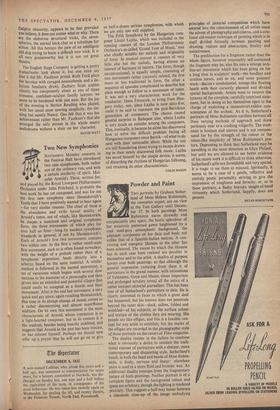Powder and Paint
Two portraits by Graham Suther- land of Mme Helena Rubinstein, the cosmetics expert, are on view at the Tate Gallery until Decem- ber 17. In both paintings Mme Rubinstein stares shrewdly and complacently into space, the hectic splendour of her massively patterned gown heightened by a cool steel-grey atmospheric background, the adamant composure of her face and body not unlike that of a Spanish-Indian matron. A con- vincing and energetic likeness to the sitter has been achieved. The means by which this likeness has in each case been realised are peculiar in themselves and to the artist. A duality of purpose hovers over both paintings, so that although the general impression radiating from them is of portraiture in the grand manner, with intimations of Velazquez, Goya and Manet, closer inspection and prolonged scrutiny reveal all the antics of a rather inexpert pictorial journalism. This has been true of all Sutherland's portraiture to date. He is clearly interested in faces to which a great deal has happened, but his interest does not penetrate beyond the outer skin—slack, sallow, folded and wrinkled—of his subjects, or the surface colour and texture of the clothes they are wearing. His people are like effigies, and this is a feasible con- cept for any artist to establish; but the masks of the effigies are recorded in the photographic style of those portraits on the covers of Time magazine.
The duality resides in the failure to combine what is obviously a desire to emulate the tradi- tional manner of portraiture with a sharper, more contemporary and disquieting style. Sutherland's touch, in both the head and hands of Mme Rubin- stein, is lively, nervous and linear : elsewhere paint is used in a more fluid and broader way. An additional duality emerges from the fragmentary nature of both paintings. Neither portrait is of a complete figure and the background colour and space are arbitrary, though the lighting is rendered precisely. This suggests a half-way house between a cinematic close-up of the image embodying principles of pictorial composition which have entered into the consciousness of all artists since the advent of photography and cinema, and a con- fused old-master technique of painting which is in itself divided formally between painting and drawing, realism and abstraction, finality and tentativeness.
The predilection for a fragment rather than the whole figure, however reasonably self-contained the fragment may be, also fits into a strange anti- fine-art movement which has been going on for a long time in sculptors' work—the headless and armless torsos, and so on, and some painters' work—Bacon's insubstantial, mirage-like floating heads with their cursorily planned and divided spatial backgrounds. Artists want to remove the tyranny of the complete, carefully contrived state- ment, but in doing so lay themselves open to the charge of exploiting a museum-art-ridden con- sciousness of the archaic. As it is, Sutherland's portraits of Mme Rubinstein vacillate between all these varying methods of approach and skate perilously near to a crashing vulgarity. The treat- ment is hesitant and uneven and is not compen- sated for by the strength of the colour or the totem-like simplicity of Mme Rubinstein's pos- ture. Depressing to think that Sutherland may be travelling in the same direction as Glyn Philpot, but until we are allowed to see better evidence of his recent work it is difficult to think otherwise. Sutherland's gifts are formidable and very special. It is tragic to see them so misused. Spiritually, it seems to be a case of a gentle, reflective and entirely poetic personality striving to give the impression of toughness and ferocity; or, as in these portraits, a flashy bravura sleight-of-hand virtuosity which Sutherland, happily, does not possess.














































 Previous page
Previous page